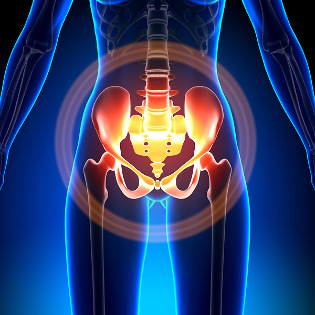Pretty common diagnosis in medical practice recently became the varicose veins of the small pelvis, and it is found in both men and women. However, statistics indicate that women are faced with this problem more often than the opposite sex. Of varicose veins of the pelvis affects all age groups of women, but with increasing age, and increases proportionally the risk of this disease. In the reproductive varices of the vessels of the small pelvis can be detected in 15-20% of women in menopause is diagnosed it is already at 75-80% of patients. In males the initial symptoms of the veins in the pelvic area most often occur in the range of 12 to 30 years.

REASONS FOR THE EMERGENCE OF VARICOSE VEINS OF THE PELVIS AND THE PECULIARITIES OF ITS DEVELOPMENT IN WOMEN AND MEN
The development of this disease contributes to a number of reasons. Some of them depend on heredity and general health, while others are the result of lifestyle and diet. The factors causing the appearance of varicose veins in the pelvis, are:
- pathological dilatation of the rectum and the lower limbs;
- genetic predisposition;
- congenital weakness of the connective tissue and venous walls;
- the development of tumors, tumors and hernias in the urogenital system;
- inflammatory diseases of the pelvic organs in the chronic form;
- sedentary and static sport;
- heavy physical effort;
- forced prolonged sitting or standing;
- the lack of regular sexual life;
- nerve disorders and often a lack of sleep;
- poor diet and excess body weight;
- bad habits.
Depending on the sex of the above list is supplemented by a variety of factors. For example, among men, this factor can be a non-standard feature of the structure of the blood vessels of the genitals. This condition is called varicocele – varicose veins of the spermatic cord. Given the characteristics of the male anatomy, we can say that most of the diseases is localized on the left side.
Features of the development of varicose veins of small pelvis in women (the so-called female varicocele) are due to the presence of the following risk factors:
- inflammatory gynecological diseases;
- mechanical compression of the veins by the enlarged uterus;
- sexual disorders (discomfort during sex, and anorgasmia);
- polyhydramnios and multiple pregnancy;
- numerous and heavy labour;
- the hormonal changes;
- hormonal therapy and contraception.
It is worth noting that, despite the greater prevalence, varicose veins of the pelvis are poorly understood, and perhaps there are other reasons for its occurrence.
VARICOSE VEINS OF SMALL PELVIS, THE SYMPTOMS AND THEIR CHARACTERISTICS IN WOMEN AND MEN
Signs of varicose veins of small pelvis in the early stages of the disease do not show any symptoms. In female patients who have symptoms, which often can only be revealed by using the methods of palpation, ultrasound, functional tests and a physical examination. Only when the extent of damage to the veins is very high, varicose veins can manifest deformity of the penis, and severe pain even at rest.

Patients of both genders pain in the varicose veins of the pelvis begin to appear with the development of pathological changes in the blood vessels and reduces the flow of blood. They are located in the lower abdomen and to have a different intensity, most patients report pain and nagging pain, giving in sacrolumbar area. They occur or to become more pronounced when walking, after prolonged static and dynamic loads.
Varicose veins of small pelvis in women the symptoms are more pronounced than that of the men:
- pain attacks in the abdomen are spread from the area of the perineum and increase, usually after a long stay in the standing or sitting; in the first days of menstruation, after exposure;
- unpleasant sensations in the genital area and the pelvis during sex and after some time it ;
- pronounced premenstrual syndrome;
- the failure of the menstrual cycle (dysmenorrhea): an increase in the duration and abundance of menstruation;
- increased secretion of the glands of the external genital organs;
- venous nodules in the crotch area;
- separate zone sensitivity on the perineum;
- dysfunction of urination.
VARICOSE VEINS OF SMALL PELVIS IN PREGNANCY
Pregnancy is a special indicator of the health of the woman. The disease is asymptomatic, in the period of gestation.
During pregnancy, the rapidly growing uterus takes up more and more space in the pelvis. At the end of the third trimester, it reaches the maximum possible size and compresses other organs, constricting the venous vessels. Their walls, due to the reduction of uterine tone, in this period, much weaker than usual. This physiological process is detrimental to health and pregnancy may be complicated with rupture of the veins, bleeding. And postpartum anemia and painful sensations, which leads to problems with the veins.
With the growth of the fetus, the outflow of blood from the cervix increases of about 15-20 times, and valve apparatus of the vessels of the cervix are not always able to deal with it. It is a violation of the unidirectional flow of blood, causing venous congestion and inflammation. The blood begins to take place in the indirect route, which included a weak small vessels of the organs in the pelvis. This leads to an excess of blood and, as a consequence, there is varicose veins of the pelvis. It is possible that after the birth of children can occur in the reverse process, and the disease will retreat.
Due to the impairment of the flow of blood veins of the pelvis leads to a lack of oxygen to the baby. Hypoxia of the fetus, sometimes it is the reason for the caesarean section.
During pregnancy it is especially important to not confuse varicose veins of the uterus and pelvis. To establish an accurate disease only will the survey methods, with a high degree of diagnostic ability: ultrasonography (us), computed tomography (CT) and magnetic resonance imaging (MRI). In this period of life women is an advantage for ultrasound and MRI, because CT involves radiation exposure. MRI is absolutely safe, but it is not recommended to be done in the first trimester. Indications for MRI with varicose veins of the pelvis are the results of the ultrasound.
In the course of pregnancy to treat varicose veins of the pelvis using only conservative methods of therapy. So completely get rid of the disease can be after the birth. In extremely critical situations, the application of surgical intervention. Then use minimally invasive techniques – radio-frequency and laser coagulation.
In the treatment without surgery. all recommendations, mainly refer to the change in life-style are:
- increasing your physical activity. To make the Walk at least two hours a day, with an obligatory vacation;
- to eliminate lifting;
- you need to stick to a diet which includes products rich with fiber (cereals, fruits and berries, vegetables) and with a high content of healthy fats;
- to take a contrast shower, to pool;
- from the second trimester to be sure to wear a certain kind of compression hosiery or prenatal bandage;
- sleep better on his side with a slightly raised feet;
- exercise and respiratory therapy.
When there is imminent danger of premature birth, the treatment maintained a stable, under the auspices of the medical staff.
THE TREATMENT OF VARICOSE VEINS OF SMALL PELVIS: THE USE OF DRUGS AND THERAPEUTIC EXERCISES
Varicose veins of the pelvis treatment consists of therapy, various medications and special gymnastic exercises.
The use of essential drugs in the acute stage of the disease. The main active components are: diosmin, hesperidin, troxerutin, pentoxifylline. Vitamins and pills that contain juice, extracts and vegetable oil, will also give a modest improvement of the patient's condition.
Pregnant women, the doctors are trying to prescribe the means (with varicose veins of small pelvis) only on the basis of natural ingredients: extract of horse chestnut, green tea extract, vitamins, oils, etc. Then there are those drugs that have fewer side effects. Often the attending physician of holistic therapy provides a referral for physiotherapy or remedial gymnastics.
Gymnastics with varicose veins of small pelvis have a wide range of activities. They are the main form of treatment, which simultaneously has preventive value. Exercises involve the back muscles, peritoneum, pelvis and hips, have a positive effect on improving the flow of blood. Given the intensity of the load, especially health, employment and at home, you can pick up a reasonable set of exercises.
Exercises for home can include the following complex:
- exercise "Bike": the rotation of legs, lying on his back. 15-20 approaches;
- exercise "to the knees": raise the chest to the knee, to toe, to correct this position for a few seconds. 10 reps on each leg;
- exercise "Scissors": in supine position, keep arms at sides, legs straight, toes stretched themselves, in turn, crossed legs. 15 approaches;
- exercise "Candle": the head, neck, and shoulders are on the floor, the body must be secured in a vertical position, the arms can hold hands, not to 5-7 minutes;
- exercises for flexibility of the back part: the support should be on hands and knees, first bend, and then straighten the arms. 10 approaches.
The job, for example, you can perform the following exercises:
- the search and strengthening of the fingers;
- circular rotation of the legs in the sitting position, 10 times;
- alternate transfer of body weight on one leg, then the other.
In the initial stages of the disease to complement the treatment of varicose veins of the pelvis can folk remedies. These include the adoption of tonic baths, the use of anti-inflammatory extracts and promote blood decoction.
Most of these tools are easy to prepare at home. Parameters in the treatment of the disease is given: fruit and flowers of horse chestnut, birch chaga, dandelion root, chamomile flowers.
Special place in treatment is prevention:
- adherence to a healthy lifestyle (quitting Smoking and alcohol consumption);
- diet (eat small portions 5 times a day in equal intervals of time);
- the optimal rate of activity and of rest;
- sexual life after of varicose veins of the pelvis, should be moderately;
- regular monitoring of blood parameters;
- visit to the phlebologist.
After recovering from the disease, the patient will notice improvement not only physical but also emotional state.





































